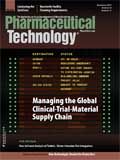Near Infrared Analysis of Tablets Containing Two Active Ingredients
The study evaluates near-infrared analysis of tablets nominally containing 4 mg of chlorpheniramine maleate and 10 mg of phenylephrine hydrochloride per dose.
Near-infrared spectroscopy (NIRS) is an analytical technique based on absorption measured in the near-infrared (NIR) region of the electromagnetic spectrum between the visible and the mid-infrared. The strong fundamental absorption bands of functional groups occur in the mid-infrared. The overtone absorptions of these fundamental bands occur in the NIR spectral region and allow direct measurement without sample preparation because of the relative weakness of absorption. The OH, CH, NH, and SH bonds have the strongest overtone absorbance in the NIR region. Because of the overlapping absorbance bands in the NIR region of the spectrum, quantitative spectroscopic methods require the application of multivariate analysis methods known as chemometrics. Chemometrics use mathematical and statistical algorithms to model the spectral response to chemical properties of a calibration or training set (1, 2).
The US Pharmacopeia monograph on content uniformity (CU) requires 10 samples to be tested at random from each batch to demonstrate CU. The industry has expressed interest in testing solid dosage form samples nondestructively and more frequently than the 10 per batch specified. FDA's process analytical technology (PAT) initiative for better process understanding and production monitoring has increased the interest in using NIR for intact tablet assay and CU testing (3).

Table I: Formula compositions (mg/tablet) with five-level fractional factorial design formulas.
NIR can be implemented for at-line analysis along with the thickness, hardness, and weight testing commonly performed in close proximity to the tablet press to obtain nearly real-time feedback during a production batch. Diffuse NIR transmission through the tablet is preferred to reflectance analysis because it can interrogate the bulk of the tablet cores. Reflection NIRS is used for coating analysis, but for bulk intact tablet analysis, transmission NIRS yields excellent results (4).

Figure 1: Tablet analysis in a FOSS XDS MasterLab instrument. The actual tablets under test in this study were white cores.
Wet-chemistry laboratory analysis of tablets for assay and CU is time consuming. It is routinely performed by high-performance liquid chromatography (HPLC), which requires lengthy calibration runs, the mixing of buffers, and the procurement and disposal of solvents. Analyzing 10 tablets for content uniformity could take hours, and the results may not be available to the tablet-press operators or for batch release for many days, or even weeks, after the tablets are compressed. Quality by design (QbD) techniques can be applied to measure the intact tablets with NIR at line, thus minimizing the risk of batch discrepancies and working toward the ultimate goal of parametric release (5).
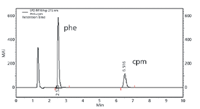
Figure 2: A representative chromatogram shows the peaks of phenylephrine (phe) and chlorpheniramine (cpm).
Experimental
Twelve batches of tablets that are 0.25 in. in diameter with a nominal weight of100 mg were formulated with a label claim of 10.0 mg phenylephrine hydrochloride (PE–HCl) and 4.0 mg chlorpheniramine maleate (CPM). The CPM and PE–HCl were varied by ± 20% of this label claim in a fractional factorial design of experiments (DOE). The lactose excipient was varied to maintain constant weight (see Table I). The tablets were compressed on a rotary tablet press (HT-AP 18 SS-U/I, Elizabeth Hata International) at the University of Tennessee's Pharmaceutical Sciences Department, the Memphis College of Pharmacy.

Figure 3: Raw diffuse transmission spectra of calibration tablets.
NIR method. The NIR instrument used in the study was an XDS MasterLab (FOSS NIRSystems). This instrument was used in the diffuse-transmission mode and sequentially measured multiple tablets positioned in a custom tray specifically designed for the tablets under test (see Figure 1). The tray was machined for 0.25-in. diameter tablets with +0.004-in. oversize tolerance for ease of fit and tablet placement without allowing stray light to pass around the tablet. Stray light is spectral energy that does not interact with the sample and therefore dilutes absorbance and reduces the sensitivity and linearity of the measurements. The MasterLab uses a standard indium–gallium–arsenide detector that has a dynamic range of more than 5.0 absorbance units. This absorbance range is required for measuring in the transmission mode through solid dosage forms. Maintaining low stray light is most important at these high absorbance levels (i.e., low light levels).
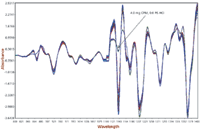
Figure 4: Second derivative math pretreatment of calibration spectra.
The tray used for this study had 31 tablet positions and was loaded to scan 10 tablets from each batch. The 10 tablets were scanned in less than 3 min., taking a reference spectrum before scanning each batch. Spectra were collected from 800 nm to 1650 nm with 0.5-nm data intervals. Thirty-two spectral scans of each tablet were coadded to produce a single spectrum to enhance the signal-to-noise ratio.
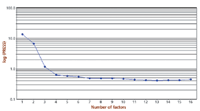
Figure 5: Predicted residual error sum of squares (PRESS) plot of partial least squares factors used to predict chlorpheniramine maleate concentration with seven factors.
HPLC method. HPLC analysis of the same tablets measured by NIR was performed at the University of Tennessee Pharmaceutical Sciences Department in the Memphis College of Pharmacy laboratory. The HPLC system was a Shimadzu vp series provided with an LC-10AD vp pump, an automatic injector SIL-10AD vp, an SPD-M10A vp diode array detector, and a DGU-14A degasser. The chromatographic analysis was performed on a 5-µm particle Luna C18 column (150 × 4.6 mm) (Phenomenex) kept in a CTO-10A vp column oven (Shimadzu) at 35 °C. Final chromatographic condition was an isocratic elution, and the mobile phase was methanol: acetonitrile: tri ethyl amine: 0.4 % sodium lauryl sulphate in the ratio of 350:300:1.5:350.
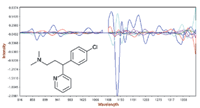
Figure 6: Partial least squares loadings that indicate where chlorpheniramine maleate is highly correlated with spectral data. The structure of chlorpheniramine is superimposed.
The mobile phase pH was adjusted to 3.8 with o-phosphoric acid. The flow rate was 1 mL/min, and the injection volume was 20 µl. Absorbance was measured at 215 nm, the wavelength of highest sensitivity for both phenylephrine and chlorpheniramine. Individual tablets were sonicated in methanol and with the mobile phase. The suspension was filtered using 0.22-µm PTFE syringe filters. The samples were diluted with the mobile phase before being injected on to chromatography. The Shimadzu CLASS-VP software was used for analysis. Figure 2 is a representative chromatogram.
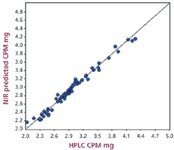
Figure 7: Calibration set. CPM is chlorpheniramine maleate, HPLC is high-performance liquid chromatography, and NIR is near infrared. R2 = 0.9811, Standard error of calibration = 0.0739 mg, Standard error of cross validation = 0.0901 mg.
Results and discussion
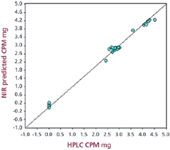
Figure 8: Validation set. Standard error of prediction (SEP) = 0.1216 mg. The N â 1 phenylephrine (PE) samples (10 mg PEâHCl, 0 mg chlorpheniramine maleate [CPM]) were tested in the validation (but not included in the SEP) and predicted results near zero, demonstrating specificity for CPM. HPLC is high-performance liquid chromatography, NIR is near infrared.
Figure 3 shows the raw diffuse transmission NIR spectra from the calibration set. By taking the second derivative of the spectra, as shown in Figure 4, the baseline was normalized and the spectral features were enhanced. The derivative was smoothed with a segment of 10 and a gap of 0.
Partial least squares (PLS) regression was used to develop the prediction model, which uses principal-component analysis and is a variation of principle-component regression. The correct number of principal components or factors was determined by the Vision software supplied with the NIR instrument by determining where the predicted residual error sum of squares (PRESS) reaches a minimum (6). Figure 5 shows the PRESS plot for the CPM PLS model selecting seven factors.
Figure 6 plots the PLS loadings that show where CPM concentration is highly correlated with spectral data. The structure of chlorpheniramine is superimposed on the plot. Aromatic C–H stretching is evident in the correlation plot at 1140 nm. The resulting CPM model had an R2 value of 0.9811 and a standard error of calibration (SEC) of 0.0739 mg. The "one-left-out" cross-validation demonstrated good predictability with a standard error of cross validation (SECV) of 0.0901 mg.
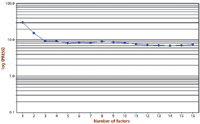
Figure 9: Predicted residual error sum of squares (PRESS) plot of partial least squares factors used to predict phenylephrineâHCl concentration using three factors.
Figure 7 shows the NIR predicted CPM level versus the HPLC values. Twenty-five percent of the total tablets scanned were randomly left out of the calibration for prediction model validation. Figure 8 shows the NIR predictions of the validation set versus the HPLC values for the CPM active ingredient. Although the model did not include zero-level CPM, the N-1 PE samples were tested in the validation. These samples contained an average of 8.95 mg PE–HCl and no CPM. The N-1 PE samples predicted at 0.0 mg CPM, thus demonstrating the specificity of the model for CPM. The standard error of prediction (SEP) was 0.1216 mg for the validation samples, not including the N-1 PE samples. The relative standard deviation (RSD) for the HPLC results for N-1 CPM tablets was 11.95%, and they were not used in the model.

Figure 10: Partial least squares loadings showing where phenylephrineâHCl is highly correlated with spectral data. The structure of phenylephrine is superimposed.
Figure 9 is a plot of the PRESS leading to a model with three factors for PE–HCl. Figure 10 plots the PLS loadings spectra that show where PE–HCl concentration is highly correlated with spectral data. The structure of PE is superimposed. Although O–H and N–H bonds are present in the structure, the aromatic C–H stretch is dominant at 1140 nm, which is shown in blue as the first factor (7).
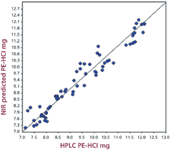
Figure 11: Calibration set. R2 = 0.9427, standard error of calibration = 0.3682 mg, and standard error of cross validation = 0.3807 mg. HPLC is high-performance liquid chromatography, NIR is near infrared, and PE is phenylephrine.
The resulting model had an R2 value of 0.9427 and an SEC of 0.3682 mg. The SECV value was 0.3807 mg. Figure 11 shows the NIR-predicted PE–HCl level versus the HPLC values. Figure 12 shows the NIR predictions of the validation set versus the HPLC values for the PE–HCl active. Although the model did not include zero-level PE–HCl, the N-1 CPM samples were tested in the validation. These samples contained an average of 3.72 mg CPM and no PE–HCl (the target was 4.0 mg CPM and 0.0 mg PE–HCl). They predicted slightly less than 0 mg for the N-1 samples because the spectra were distinctly different, as shown in Figure 3. The prediction near 0 mg demonstrated that the model is unique for PE–HCl. The SEP was 0.4758 mg for the validation samples (not including the N-1 samples). The RSD for the HPLC results for N-1 PE–HCl tablets was 8.15%, and they were not used in the model.

Figure 12: Validation set. Standard error of prediction = 0.4758 mg. The N â1 chlorpheniramine maleate (CPM) samples (0 mg phenylephrine [PE]âHCl, 4 mg CPM) were tested in the validation. The model predicted results were slightly below zero, demonstrating specificity for PEâHCl. HPLC is high-performance liquid chromatography, and NIR is near infrared.
Table II shows the repeatability results for a separate set of T-5 label claim tablets nominally containing 4.0 mg CPM and 10.0 mg PE–HCl. The standard deviation for predicting the CPM active level of these five measurements of the same tablet was 0.0104 mg. The standard deviation of the repeatability for the same tablet for nominal 10.0 PE–HCl was 0.0129 mg (see Table III).
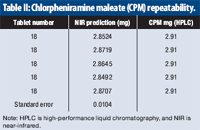
Table II: Chlorpheniramine maleate (CPM) repeatability.
The Vision software has a routine-analysis method for calculating CU automatically and produces a report that complies with 21 CFR Part 11. Table IV shows the CU results for 4.0 mg CPM in T-5 label claim tablets. Data out of the ±15% of label-claim range because of processing difficulties are in red. Table V shows the CU results for 10.0 mg PE–HCl in the same tablets.
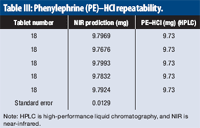
Table III: Phenylephrine (PE)âHCl repeatability.
Table VI shows the HPLC data in percent of label claim for the nominal label claim of batch T-5. The mean value for CPM (target label claim of 4.0 mg) was extremely low because of formulation and tablet-processing problems. While the variance (i.e., RSD) was not more than 6.0 % in the T-5 values, T-3 for PE–HCL was 6.26%, and T-9 for CPM was 6.68% (see Table VI).
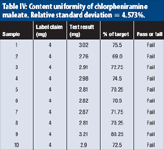
Table IV: Content uniformity of chlorpheniramine maleate. Relative standard deviation = 4.573%.
Conclusion
This study shows that the NIR assay for the determination of tablets' CU is a fast and accurate means of monitoring tablets that could be used for production and is consistent with FDA's PAT initiative. The data showed promising results that could relieve laboratory workload and bring analysis closer to real time for process monitoring. Ten tablets could be analyzed in less than 3 min. The results would be improved by eliminating processing problems that led to high within-batch variance (i.e., as high as 11.95% RSD in N-1 CPM) and meeting target label-claim values.
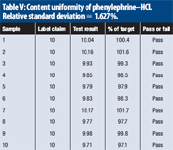
Table V: Content uniformity of phenylephrineâHCl. Relative standard deviation = 1.627%.
Robert Mattes* is an applications scientist, and Denise Root is the marketing and product specialist manager, both at FOSS NIRSystems, 7703 Montpelier Rd., Laurel, MD 20723, tel. 301.680.7251, fax 301.236.0134, rmattes@foss-nirsystems.com. Ed Brunson is an instructor of pharmaceutical sciences, Suresh Potharaju is a graduate student, Wen Qu is a research associate, James Johnson is an associate professor of pharmaceutics, and Hassan Almoazen is an assistant professor of pharmaceutics, all at the University of Tennessee Health Science Center.
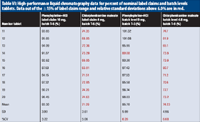
Table VI: High-performance liquid chromatography data for percent of nominal label claims and batch levels tablets. Data out of the ±15% of label claim range and relative standard deviations above 6.0% are in red.
*To whom all correspondence should be addressed.
Submitted: July 18, 2011. Accepted: Sept. 26, 2011.
References
1. J. Workman, Jr., Handbook of Near-Infrared Analysis, D.A. Burns and E.W. Ciuczak, Eds. (Marcel Dekker, New York, 2nd ed., 2001), p. 94.
2. K.R. Beebe, R.J. Pell, and M.B. Seasholtz, Chemometrics: A Practical Guide, (John Wiley and Sons, Hoboken, NJ, 1998), p. 1.
3. FDA, PAT: A Framework for Innovative Pharmaceutical Development, Manufacturing, and Quality Assurance (Rockville, MD, Sept. 2004).
4. R. Mattes et al., Pharm. Technol. 31 (4), 170–182 (2007).
5. P.J. Larkin, E. Fruhling, and C. Longfellow, Am. Pharm. Rev. 9 (6) (2006).
6. R. Kramer, Chemometric Techniques for Quantitative Analysis, (Marcel Dekker, New York, 1998), p. 60.
7. J. Workman, Jr. and L. Weyer, Practical Guide to Interpretive Near-Infrared Spectroscopy, (CRC Press, Boca Raton, FL, 2008), p. 43.
